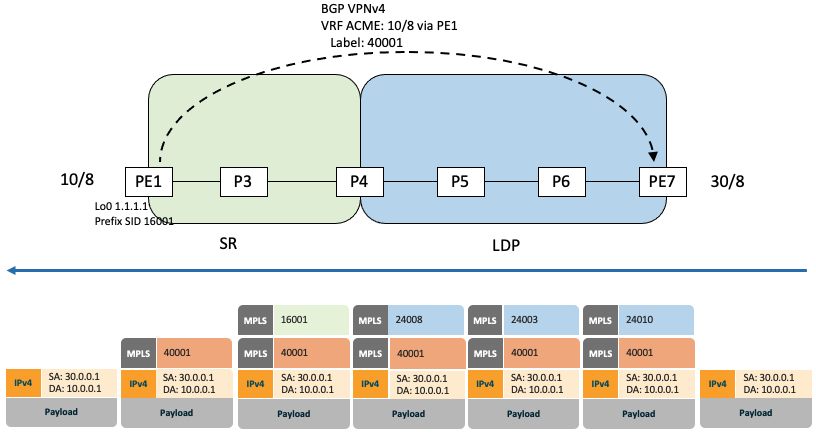Segment Routing Mapping Server
The mapping server functionality in Cisco IOS XR segment routing centrally assigns prefix-SIDs for some or all of the known prefixes. A router must be able to act as a mapping server, a mapping client, or both.
-
A router that acts as a mapping server allows the user to configure SID mapping entries to specify the prefix-SIDs for some or all prefixes. This creates the local SID-mapping policy. The local SID-mapping policy contains non-overlapping SID-mapping entries. The mapping server advertises the local SID-mapping policy to the mapping clients.
-
A router that acts as a mapping client receives and parses remotely received SIDs from the mapping server to create remote SID-mapping entries.
-
A router that acts as a mapping server and mapping client uses the remotely learnt and locally configured mapping entries to construct the non-overlapping consistent active mapping policy. IGP instance uses the active mapping policy to calculate the prefix-SIDs of some or all prefixes.
The mapping server automatically manages the insertions and deletions of mapping entries to always yield an active mapping policy that contains non-overlapping consistent SID-mapping entries.
-
Locally configured mapping entries must not overlap each other.
-
The mapping server takes the locally configured mapping policy, as well as remotely learned mapping entries from a particular IGP instance, as input, and selects a single mapping entry among overlapping mapping entries according to the preference rules for that IGP instance. The result is an active mapping policy that consists of non-overlapping consistent mapping entries.
-
At steady state, all routers, at least in the same area or level, must have identical active mapping policies.
Usage Guidelines and Restrictions
|
Feature Name |
Release Information |
Feature Description |
|---|---|---|
|
Advertisement of SID-Mapping Entries Between IS-IS Levels |
Release 7.3.1 |
The Segment Routing Mapping Server (SRMS) is a key component of the interworking between LDP and segment routing, enabling SR-capable nodes to interwork with LDP nodes. This release introduces support for SRMS SID-mapping entries to be advertised between IS-IS levels (for example, from Level 1 to Level 2-only and from Level 2 to Level 1), where previously, the mappings were advertised only within the same IS-IS level, but not between IS-IS levels. This feature simplifies and centralizes the deployment of SRMS by removing the requirement of having a mapping server for each IS-IS area. |
-
The position of the mapping server in the network is not important. However, since the mapping advertisements are distributed in IGP using the regular IGP advertisement mechanism, the mapping server needs an IGP adjacency to the network.
-
The role of the mapping server is crucial. For redundancy purposes, you should configure multiple mapping servers in the networks.
-
The mapping server functionality supports the advertisement of SID-mapping entries between IS-IS levels (for example, from L1 to L2-only and from L2 to L1). A mapping server is not required for each IS-IS area.
For example, mapping entries learned from IS-IS Type Level-1 (intra-area) routers can be used to calculate prefix-SIDs for prefixes learned or advertised by IS-IS Type Level-2-only (backbone) routers.
Use the domain-wide option to advertise the prefix-SID mappings between Level 1 and Level 2 IS-IS routers.
-
The mapping server functionality does not support a scenario where SID-mapping entries learned through one IS-IS instance are used by another IS-IS instance to determine the prefix-SID of a prefix. For example, mapping entries learnt from remote routers by 'router isis 1' cannot be used to calculate prefix-SIDs for prefixes learnt, advertised, or downloaded to FIB by 'router isis 2'. A mapping server is required for each IS-IS instance.
-
Segment Routing Mapping Server does not support Virtual Routing and Forwarding (VRF) currently.




 Feedback
Feedback